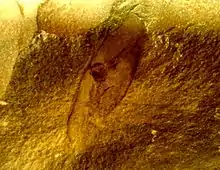Typhloesus
Typhloesus wellsi is an extinct species of enigmatic bilaterian animals from the Bear Gulch Limestone. It was once thought to be the first body fossil of a conodont,
| Typhloesus wellsi Temporal range: | |
|---|---|
 | |
| Scientific classification | |
| Kingdom: | Animalia |
| Clade: | ParaHoxozoa |
| Clade: | Bilateria |
| Genus: | †Typhloesus (Conway Morris, 1990) |
| Species: | †T. wellsi |
| Binomial name | |
| †Typhloesus wellsi (Melton and Scott, 1973) | |
Description
It has a fusiform (spindle-shaped) body, with a maximum length of 90 mm. At the posterior or backside of the animal is a caudal fin, which was supported by two sets of orthogonal fin rays. The exterior lacks any other organs. The internal anatomy consists of a foregut and a midgut. The gut lacks a midsection and an anus. Beneath the midgut is a disc shaped organ, tentatively called a ferrodiscus, it is unknown to what the purpose of this organ is, however it has a high concentration of iron.[1]
Paleoecology
It might have been both a predator and a scavenger, as its fossils sometimes contains conodont teeth and worm teeth located in the midgut of the animal.
They could be survivors from the "Cambrian explosion" in which a multitude of bizarre body plans evolved, or they could represent the results of adaptive radiations nearer to the Carboniferous. [2]
See also
References
- Conway Morris, Simon (1990-04-12). "Typhloesus wellsi (Melton and Scott, 1973), a bizarre metazoan from the Carboniferous of Montana, U. S. A". Philosophical Transactions of the Royal Society of London. B, Biological Sciences. 327 (1242): 595–624. doi:10.1098/rstb.1990.0102.
- Morris, S. Conway (1990). "Typhloesus Wellsi (Melton and Scott, 1973), A Bizarre Metazoan from The Carboniferous of Montana, U.S.A." Philosophical Transactions of the Royal Society of London. Series B, Biological Sciences. 327 (1242): 595–624. ISSN 0080-4622.